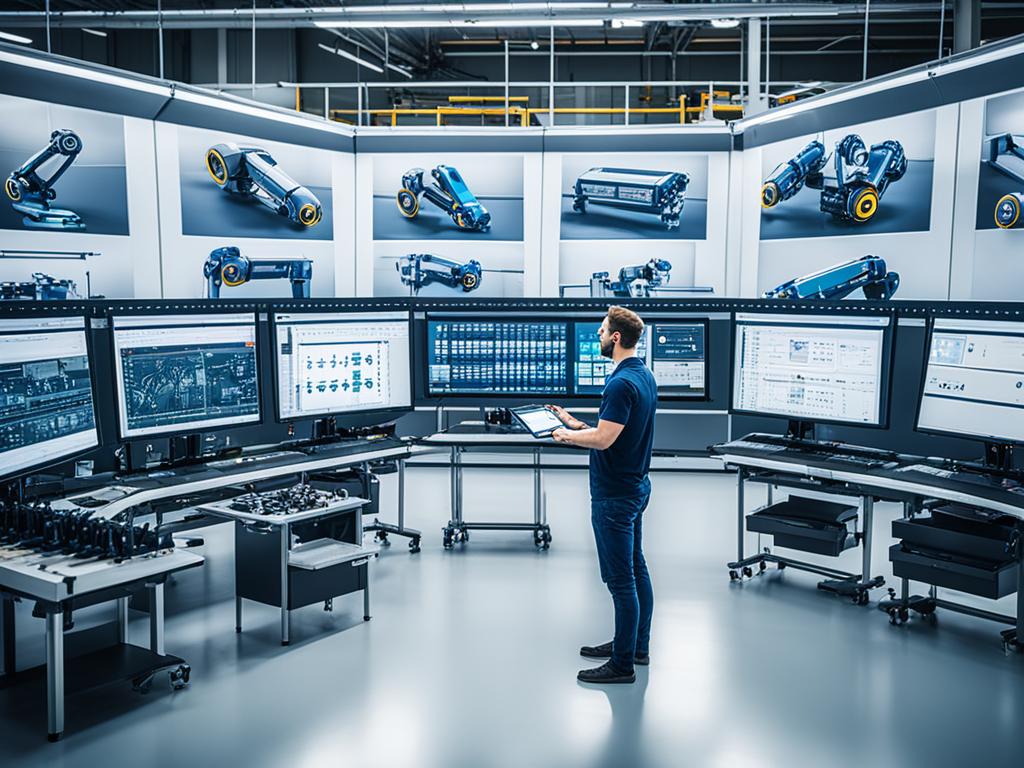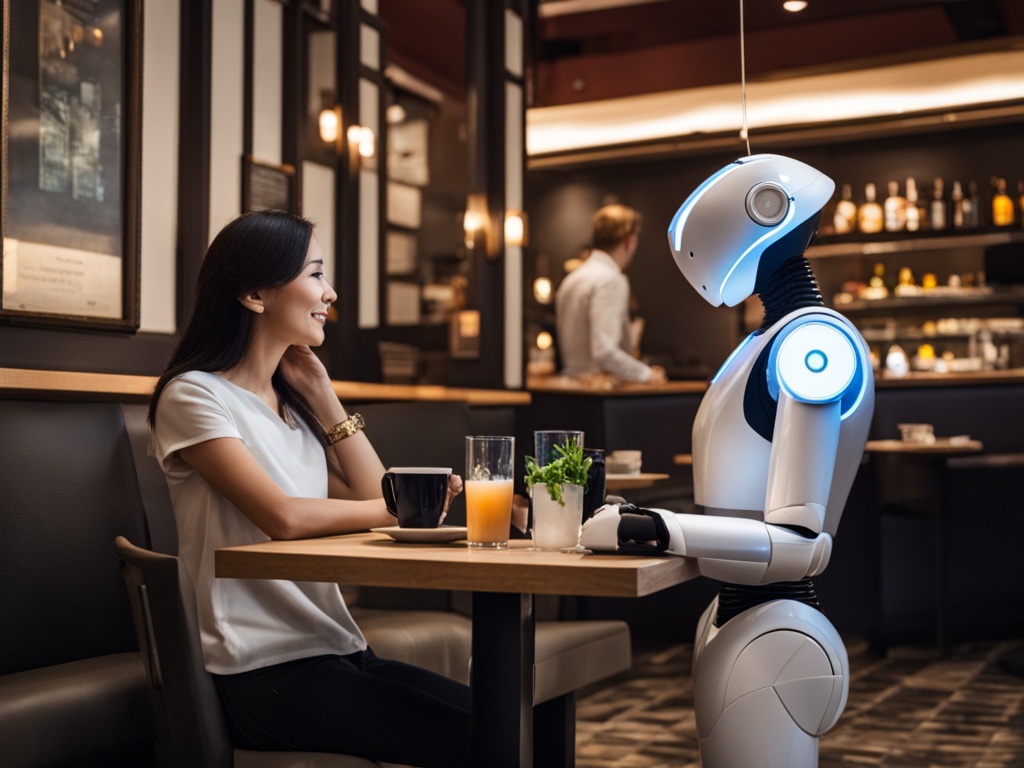Have you ever thought about AI weaving into our lives or changing industries quickly? This idea of AI has moved from sci-fi stories to being a key tool. It boosts efficiency, accuracy, and work output in many areas. We see this in healthcare innovations and in the smart assistants we use every day.
AI’s breakthroughs are core to this shift, continuously setting new standards and reshaping tech. The days when AI seemed a far-off notion are over. Its real-world effects are now very clear in business, healthcare, and our daily lives. Exploring AI’s vast powers and what it could bring next is both intriguing and vital.
Key Takeaways
- AI is now an integral part of various industries, enhancing efficiency and productivity.
- Advanced AI applications are reshaping how we approach business, healthcare, and everyday tasks.
- AI innovations continue to introduce groundbreaking capabilities, driving technological evolution.
- The integration of AI into daily life is steering immense changes in our personal and professional environments.
- Understanding AI’s current applications and potential is crucial for navigating the modern world.
The Evolution of Artificial Intelligence
Artificial intelligence has grown incredibly since it started. It began with basic, rule-based tasks and now has machine learning and neural networks.
A big moment for AI was creating machine learning. This lets systems learn from data and get better without direct instructions. Techniques like decision trees and support vector machines led to today’s smarter apps.
The rise of neural networks was also key. They mimic the human brain with nodes that work together. This change made things like understanding images and speech, translating languages, and self-driving cars possible.
The following table highlights some key historical milestones in AI development:
| Year | Milestone | Impact |
|---|---|---|
| 1956 | Dartmouth Conference | Birthplace of AI as an academic field |
| 1997 | IBM’s Deep Blue defeats Garry Kasparov | Showcased potential of machine learning algorithms |
| 2012 | AlexNet wins ImageNet contest | Set new benchmarks for neural network performance |
| 2020 | DeepMind’s AlphaFold predicts protein structures | Revolutionized biochemistry and drug discovery |
These milestones show the big impact of machine learning and neural networks on AI. AI has moved from simple systems to machines that think and learn.
Thinking about AI’s future is exciting. We expect more growth in machine learning and neural networks. This could open up new possibilities.
AI Applications in Everyday Life
Artificial intelligence is now a big part of our daily lives, sometimes without us knowing. It handles chores and helps in healthcare, making things better and easier for us.
Smart Homes
Smart homes are changing the way we live. Technologies like the Google Nest learn what temperatures you like. Smart security systems keep us safe by checking for dangers and telling homeowners.
They use special computing to get used to your habits and make your home better.
Personal Assistants
Assistants like Amazon’s Alexa and Apple’s Siri help us a lot. They organize our days, remind us of things, and give quick information. These tools are great for people who are always busy.
They work by understanding what we say naturally, which helps them answer us better and do things without us touching anything.

Healthcare Innovations
AI has a big effect on healthcare, making things faster and more personal. Platforms like IBM Watson Health go through a lot of data to help predict how patients will do and suggest treatments. These changes are making healthcare better, with more accurate and faster help for patients.
Machine Learning: The Backbone of AI
Machine learning is at the heart of artificial intelligence. It drives the innovative AI apps we use today. It learns from lots of data, which is key to its success.
This field is amazing because it can find patterns and make choices with little help from us. It supports many areas, from easy tasks to very complex ones.
Let’s look at some key parts of machine learning:
- Data Analytics: By deeply analyzing data, algorithms in machine learning can find important info, see trends, and help make smart choices.
- AI Applications: These tools are used in many areas, like understanding language, recognizing images, and self-driving tech. They’re changing how we use technology.
Machine learning is crucial for AI’s future. It keeps getting better at what it does and dealing with more data. Soon, machines will not just help but also improve our lives in ways we’ve never seen before.
Cognitive Computing: Mimicking Human Thought
Cognitive computing is a thrilling area that tries to copy how humans think but in computers. It uses high-tech systems that learn on their own. These systems use data mining, pattern recognition, and natural language processing to act like humans.
Understanding Cognitive Computing
We dive deep into cognitive computing to see how it works like our minds. It uses data mining to find patterns, pattern recognition to sort data, and natural language processing to understand and speak like us. So, we get machines that think and process info like we do.

Real-World Applications
Cognitive computing is changing the game in the real world. Companies use it to make smart customer service bots that talk and help like humans. It also powers automation technology in many fields. This makes processes smoother and helps with making better decisions.
The table below shows how cognitive computing is making a difference in various industries:
| Sector | Application | Benefit |
|---|---|---|
| Healthcare | Personalized Treatment Plans | Improved Patient Outcomes |
| Finance | Risk Management | Enhanced Decision-Making |
| Retail | Customer Service Bots | Increased Customer Satisfaction |
This shows how cognitive computing’s smart ways are changing industries. By following how humans think, these systems are boosting how we work. They bring better efficiency, more personal touches, and higher productivity.
Data Analytics Powered by AI
Data analytics is now more powerful thanks to AI. Machine learning and neural networks are changing the game in business and research.
AI algorithms quickly go through huge amounts of data. They pull out important insights, predict trends, and help make better decisions. This lets companies act based on strong data, which was hard before because of data’s size and complexity.
| Benefit | Description |
|---|---|
| Automated Data Processing | AI makes handling big datasets faster and easier by automating the process. |
| Enhanced Accuracy | Neural networks help AI make more accurate predictions and outcomes. |
| Scalability | AI systems can manage more data without losing performance. |
| Real-time Analysis | Machine learning gives businesses instant insights, helping them quickly adapt to trends. |
Using AI for data management adds a lot of value in today’s economy. Machine learning and neural networks give businesses the edge with powerful analysis tools.
Revolutionizing Industries with Automation Technology
Automation technology, powered by recent AI innovations, is changing industries. It improves manufacturing and makes services more efficient. Cognitive computing’s role is clear and impactful.
Manufacturing Automation
In manufacturing, automation changes the game. Robots and systems do repetitive work with great accuracy. This boosts product quality and makes everything consistent. Also, AI helps in predicting maintenance needs. This keeps machines running smoothly without unexpected stops.
Service Industry Automation
The service sector also gains from AI in automation. Financial services use cognitive computing to speed up transactions and catch fraud as it happens. AI makes customer services better. It helps in giving personalized and quicker replies, pleasing customers more.
| Industry | Application | Benefits |
|---|---|---|
| Manufacturing | Robotic Assembly | Enhanced precision and consistency |
| Service | AI Customer Service | Improved user satisfaction and efficiency |
Understanding Neural Networks
Neural networks are inspired by our brains and shape deep learning and machine learning. They learn on their own and make smart choices, like humans do.
These networks are key for tasks such as recognizing images or speech, driving cars without a person, and translating languages in real-time. They have many layers and connect like brain cells. This setup is great for spotting patterns and analyzing data.
Let’s explore what makes up neural networks:
- Input Layer: This layer takes in data and sends it on for more work.
- Hidden Layers: These layers do most of the heavy lifting. They’re essential for learning from data.
- Output Layer: Here’s where we get the final result, after all the processing is done.
Check out these neural network types and what they do:
| Neural Network Type | Primary Use Case | Advantages |
|---|---|---|
| Convolutional Neural Networks (CNNs) | Image Recognition | High accuracy in visual data processing |
| Recurrent Neural Networks (RNNs) | Time Series Analysis | Great for data that follows a sequence and making forecasts |
| Generative Adversarial Networks (GANs) | Data Generation | Can create realistic data samples from scratch |
Knowing about different neural networks can open doors in deep and machine learning. They’re good at dealing with lots of data. This helps make AI systems more advanced and smart.
The Rise of Deep Learning
Deep learning has truly changed the world. It’s a part of machine learning, using deep neural networks to understand complex data. It works like the human brain. This change has made AI applications better and more effective. We’ll look at the key features of deep learning.
What is Deep Learning?
Deep learning uses neural networks with many layers. This allows it to analyze data deeply. These networks handle a lot of information, finding patterns and making accurate decisions. Deep learning is key in AI, driving new ideas and improving different areas.
Deep Learning in Image and Speech Recognition
Deep learning shines in image and speech recognition. Neural networks let systems understand visuals and sounds well. This tech is behind things like facial recognition and voice assistants like Amazon Alexa and Google Assistant.
To make it simple, let’s compare old and new methods in these areas.
| Aspect | Traditional Methods | Deep Learning Methods |
|---|---|---|
| Image Recognition | Feature Extraction by Humans | Automated Feature Extraction |
| Speech Recognition | Basic Keyword Spotting | Contextual Understanding |
| Performance | Limited by Human Input | Enhanced by Learning Algorithms |
As deep learning evolves, its uses will grow. This will expand what AI can do.
AI Innovations Shaping the Future
Artificial intelligence (AI) will have a big impact on our future. Innovations in areas like quantum computing are leading the way. Quantum computing uses quantum mechanics to speed up information processing. This could help solve problems that once seemed too complex.
Automation is becoming a bigger part of our lives. It’s changing how industries work, from drones delivering packages to robots in factories. Companies like Amazon and Tesla lead in using automation to improve supply chains and production. This is making things more efficient and precise.
Cognitive computing tries to think like humans do. It could make digital assistants that understand and anticipate our needs better. This would make customer service more intuitive and helpful. Improving these systems is key for a connected world.
AI innovations are setting us on an exciting path that could change daily life and society. With more development in automation and cognitive computing, we might see big changes. Are we prepared for this future? I’m excited to watch these advancements unfold.
